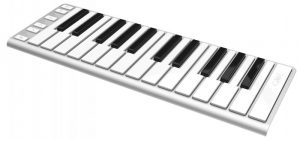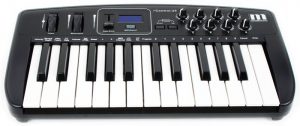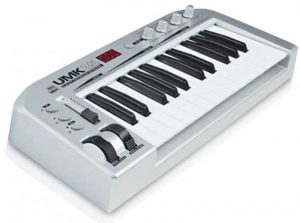Gear Review: Five MIDI Controllers Compared
Gear Review: Five MIDI Controllers Compared
This issue’s multi-love gear review saw SAE Institute’s Recording Arts degree class test five portable and inexpensive MIDI keyboard controllers, all within a very comparable price range – only a few bucks between them – yet offering a surprising variety in their feature sets.
A MIDI keyboard controller has no on-board sound banks, it merely produces MIDI notes and other performance data through a variety of means such as black and white keys, knobs, buttons, sliders and pads, and feeds those via USB (or a 5-pin DIN cable) into the computer where they trigger sounds within software-based synths, samplers or drum machines. They can, of course, also be connected old school to the sound module inside a keyboard or to a hardware synth, with no computer involved. And you can also use them to control faders, knobs, plug-ins and transport functions in a DAW like Logic, ProTools or Ableton. So you can see how useful they can be to have around. Now, let’s get to it.
Samson Graphite M25 rrp $149
The Samson Graphite, (see main pic) as with all the other devices on review, is a class-compliant USB bus-powered plug-and-play controller. The mini-USB port is the only socket you will find, providing both power and MIDI connectivity, which of course is good news when you are on the go with your laptop (or iPad if you have a connector kit), but less useful if you are working with hardware synths and have no access to bus power.
It features 25 velocity-sensitive keys, eight MIDI-assignable rotary encoders, two banks of four assignable trigger pads with aftertouch, five transport controls, a master encoder and seven back-lit function buttons – a rich feature set indeed. You can also download a dedicated editor that enables you to set program and control change functionality via the trigger pads, as well as program and save four global presets.
The Samson has a very contemporary look and is surprisingly lightweight, the second lightest device on review here. Being a knob-twiddler, and a very rudimentary keyboardist, to put it politely, I found myself enjoying the functionality of this baby straight away. The keys are very responsive, even though way too small for my grown-up fingers. Luckily, I have no playing technique they could get in the way of. The pitch bend and mod wheels have been replaced by touch-sensitive strips that I found a lot of fun sliding my fingertips up and down on, but would probably make any serious player frown, and are most probably not as accurate and responsive as the real thing. Mind you, they won’t easily get damaged in a backpack, either.
I set up the transport functions to control my Logic session via Logics Key Commands with no trouble and had fun moving faders and sliders with the rotary controls. If you want to control the transport with MIDI Machine Control (MMC), e.g. in ProTools, you can use the free editor to do so, too. Loading a drum kit, I found the included pads to be the highlight. They are very responsive and playable, even down to aftertouch functionality. Thats quite unexpected in this price range.
The Samson really is a well-thought out product and stands alongside three other compact controllers in its family, with slightly varying feature sets to address different user profiles, that are also worth checking out.
If there is anything detracting from this excellent piece of gear, its a slightly flimsy feel of its build quality, compared to some of the other devices on review. However, at this price it does punch a lot a bang in your buck, if you pardon the mixed metaphor, and I would thoroughly recommend it to any knob-twiddling laptop producer.
Playability 7/10
Functionality 9/10
Portability 9/10
Design Quality 7/10
CME XKey rrp $149
When we unpacked the CME XKey, I already knew that this was going to be a tough one. There is a design philosophy at work here that does not easily compare with the other controllers on review. You see, this beautifully crafted, super-sturdy, brushed aluminium personality resembles an Apple computer keyboard more than a MIDI controller keyboard, and should really be called iKey or something along those lines. What’s clear is that in achieving this a lot of functional sacrifices were made.
The 25 near-full-size, velocity-sensitive keys with polyphonic aftertouch look like a row of vertical spacebars and even the gaps in between them are consistent with the Apple keyboard look. On the left-hand side are six simple function buttons taking care of octave changes, pitch-bend, modulation and sustain. There is a micro USB socket at the back with an associated power LED that lights up when the keyboard is connected to either a desktop computer, a laptop or an iPad (although as with all the reviewed keyboards, a connector kit is not included). And that’s it! A clear case of form over function one might think, and there are problems here.
Due to the low profile of the board there is no key travel to speak of, and no pivot point for the keys, which makes it almost impossible to play with proper dynamics. There are no wheels or pedals for expression, just unintuitive buttons, and there is no visual feedback as to the controller and octave positions. Functionality in general is kept to the bare minimum, and expressive playing is hard to achieve. However, if you are an untrained player and used to step-inputting your notes this is a very useful approach. And the velocity response curves can be somewhat modified via the free XKey Plus app.
On a massive upside though, this keyboard, with its tiny 618g weight and miniature footprint, literally can go where no keyboard – apart perhaps from the Samson Graphite , if you cram it – will ever be able to comfortably go, into a snug compartment inside your laptop bag, then onto a plane, perhaps into the Amazon rainforest or maybe even into space.
I recently watched an astronaut perform Bowie’s Space Oddity from within a spacecraft and swear I saw him play this keyboard. (Just kiddin of course.) But, given that we are comparing apples with oranges, the awarded scores below for the CME are at quite extreme ends, and if you are a producer that likes to travel light and compose on a plane (or spacecraft), you may find that the advantages outweigh the shortcomings, and this beauty might prove to be right up your alley.
Playability 4/10
Functionality 5/10
Portability 10/10
Design Quality 10/10
Miditech i2 Control 25 rrp $169
Sure, there are no trigger pads or transport controls, but the Miditech i2 isn’t really far behind the first-up reviewed Samson with its own very impressive feature set. This controller has a number of desirable selling points many musicians will appreciate.
The 25 velocity-sensitive keys come in full size and playability was the second best of the reviewed models, with just the right amount of stickiness in the keys, and two very playable wheels for modulation and pitch bend. I wish they had put the wheels to the left where you expect them to be, but inexplicably they wound up above the keyboard.
Next to the wheels you’ll find eight sturdy-looking MIDI-assignable rotary encoders, two buttons for octave changes, a display comprising three 7-segment LEDs, a data entry slider and a MIDI select button. The combination of the latter three enables you to access a whole range of MIDI parameters most typically used in controlling external hardware synths, modules and samplers, such as control and program change, transposition etc. Basically, you could be gigging without a laptop and still manage a host of hardware settings from your controller.
Reinforcing the hardware theme are several other features. On the rear you’ll find a built-in MIDI interface featuring USB, as well as two MIDI Outs of the original DIN type. You are able to connect your hardware synth, sampler or drum machine, and trigger them either from the controller or via your computer. Another welcome addition is a jack for a sustain foot pedal, and a choice of three powering options via a toggle switch – USB bus power, six AA batteries or a mains power supply (purchased separately). These make this controller independent of USB bus power and so very useful when working without a computer or iPad.
Proving that they also target the bedroom producer, Miditech includes download instructions for a range of bundled software bonuses, including EZ Drummer, Amplitube, Poizone and Finale. While Mac users may be dismayed by the inclusion of Windows-only Samplitude Silver, one has to marvel at the additional value thrown in at this price point.
The packaging at first made the Miditech look quaintly dated and somewhat cheap, but as we put it to the test we warmed to it more and more. The design philosophy certainly owes a lot of inspiration to old-school technology, but this controller holds up equally well in a modern producer set up with the added bonuses of road readiness, robustness and versatility. The small price to pay is the larger footprint and the greater weight of 1.5kgs.
Playability 8/10
Functionality 9/10
Portability 6/10
Design Quality 9/10
Korg microKey 37 rrp $169
The Korg name has been with us since the early ‘70s and weve all come to expect only the best from them, so our expectations for the microKey were obviously high too. There are 37 velocity-sensitive mini keys, which is one octave more than the other keyboards on trial here, as well as the obligatory pitch bend and modulation wheels. In case you want more or fewer octaves, Korg make 25-key and 61-key versions as well.
Two multi-coloured backlit buttons indicate the octave shift, from green for one octave, via orange and red all the way to blinking red for four octaves, a nice and very helpful touch. On the left there are three USB ports, allowing the microKey to connect to a computer as well as act as a USB hub, also really nice and helpful considering the plethora of USB devices we all now have come to rely on. A trade-off seems to be that the controller is drawing more bus power, and thus wouldnt run off my Apple keyboard ports and would presumably drain laptop and iPad batteries a little faster. Ah well…
There are no other hardware controls. However, everything from the keys to the wheels, the buttons and the casing feels sturdy and road-ready. And in fact, the key and wheel action is probably the best of all the keyboards on review. If only I were graced with slimmer micro fingers. The action is even more tweakable once you get the freely downloadable Korg Kontrol Editor. While this naturally wont make the keys bigger, it gives you the ability to customise key velocity curves and wheel assignments.
What really makes this controller stand out from the pack, and proudly beside the Miditech, is the included value. The Korg comes bundled with a collection of the famous Korg M1 sound banks, as well as a bunch of other useful third party software by Toontrack, Propellerhead and Applied Acoustics. You can load these into your favourite DAW – and if you don’t have one, ah well, there is even a download coupon for Ableton Live. Again, pretty incredible at this price!
While the front panel functionality is limited for this controller, and it ain’t the most useful for DAW control, there is a lot to like here. Korg have proven that they can make tasteful, value-laden quality gear while successfully competing with brands of lesser pedigree.
Playability 9/10
Functionality 8/10
Portability 8/10
Design Quality 10/10
Ashton UMK25 rrp $185
Unpacking the Ashton UMK, also a velocity-sensitive full-size 25-key controller, gave us a sensation of deja vú. Its function and form resemble the Miditech we had previously reviewed very closely – so naturally this became the device we tended to compare it to.
It has the same 3-digit 7-segment LED display arrangement, a bunch of MIDI control messages that can be accessed via an Edit button and the associated keys, a data slider to change control values, two buttons that allow you to transpose either in octaves or semitones, and the two mod and pitch bend wheels.
Four MIDI assignable knobs can be assigned to two parameters each, and a bank switch beside them then determines which group of four the knobs currently control. While this is perhaps ergonomically and economically advantageous, it is also one more thing to remember when you use the knobs to operate something.
The Ashton is USB bus-powered, but can also be run off a mains adapter (not supplied). It features a DIN MIDI Out connector, though this one does not appear to be an interface but rather a parallel output of the USB connection. Its nice to have though. And hooray, there is also a jack to connect your sustain pedal to, if you have one.
As already noted, the Ashton invited a comparison with the Miditech, being in the same price bracket and sharing its design brief. On the down side the Ashton keys felt just a bit too springy and weightless, the quality of the knobs and sliders wasnt the same, and footprint and weight were both larger. However we did prefer the position of the pitch and mod wheels, and the soft buttons felt better too.
The manual promised a few things I could not ascertain, such as changing the velocity response curve of the keys – which I would have welcomed – and the pedal curve. Perhaps this option is reserved for the bigger 49- and 61-key models Ashton also offers.
Overall, this is another MIDI controller that is flexible and versatile, with enough functionality for production and performance. It won’t fit in a laptop bag by a stretch, and is not built for a backpack either so might not be your preferred choice on the go, but will rest solidly on a desktop and offer you a rich set of features to keep your creative juices flowing.
Playability 6/10
Functionality 7/10
Portability 5/10
Design Quality 7/10
Karsten Schwardt is a teacher and Audio Department Leader at SAE Institute, Parnell. SAE Institute offers tertiary qualifications in audio and filmmaking. Karsten can be contacted at k.schwardt@sae.edu. The gear review was conducted in conjunction with the Bachelor of Recording Arts class of 2015, with special thanks to Pritesh Panchal.

